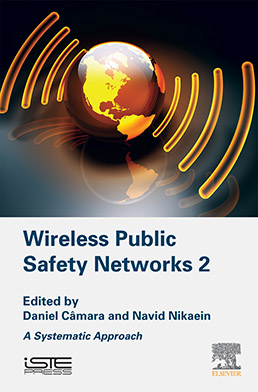
The aim of this second book of the Wireless Public Safety Networks series is to provide a system-level view of some fundamental problems linked to the PSN field. This book mainly focuses on specific enabling technologies, i.e. those which can help the most with the deployment and usage of PSNs in real world scenarios.
The first chapter is twofold. First, it makes a brief overview of the requirements and application scenarios for public safety networks, then it introduces the Internet of Things (IoT) (or Internet of Everything, IoE) paradigm and discusses the role it may play in the PSN field.
Chapter 2 discusses the use of social networks in the emergency management and the new possibilities social media may bring to the PSN field.
Chapter 3 presents the new advancements on Wearable Wireless Sensor Networks (W-WSN) for PSNs and Chapter 4 elaborates on the need to support mobile backhauling in moving-cell scenarios and describes two LTE-based solutions to enable dynamic meshing among the base stations
Chapter 5 highlights the issues and limitations of the current mobility management protocols and presents different mobility management alternatives for the future PSN in the context of 5G networks.
Chapter 6 discusses the problem of access for Public Safety Broadband Network using a twofold structure and Chapter 7 investigates the problem of data dissemination over PSNs making a review of the state of the art of different information and communication technologies.
Chapter 8 talks about the multicast dissemination of warning messages to a large population at risk, and Chapter 9 investigates eMBMS (LTE Broadcast).
Chapter 10 focuses on the best possible usage of one of the most precious resources of any wireless network, the frequency spectrum and, finally, Chapter 11 examines the challenges linked to security and privacy for PSNs as well as different techniques that may be put in place.
1. Internet of Things in Support of Public Safety Networks: Opportunities and Challenges, Ikbal Chammakhi Msadaa and Amine Dhraief.
2. The Use of Social Networks in Emergency Management, Romano Fantacci, Francesco Gei, Dania Marabissi and Luigia Micciullo.
3. Wearable Wireless Sensor Networks for Emergency Response in Public Safety Networks, Muhammad Mahtab Alam, Dhafer Ben Arbia and Elyes Ben Hamid.
4. Public Safety Networks: Enabling Mobility for Critical Communications, Romain Favraud, Apostolos Apostolaras, Navid Nikaein and Thanasis Korakis.
5. IP Mobility Management for Future Public Safety Networks, Tien-Thinh Nguyen and Christian Bonnet.
6. Public Safety Broadband Network with Rapid-deployment Base Stations, Xu Chen and Dongning Guo.
7. Data Dissemination in Public Safety Networks, Panayiotis Kolios, Andreas Pitsillides, Osnat Mokryn and Katerina Papadaki.
8. Design Aspects in Multi-channel Public Warning Systems, Cristina Párraga Niebla, Javier Mulero Chaves and Tomaso De Cola.
9. LTE Broadcast for Public Safety, Tien-Thinh Nguyen, Christian Bonnet and Ngoc-Duy Nguyen.
10. Cognitive Radio for Public Safety Communications, Ala Abu Alkheir and Hussein T. Mouftah.
11. Security and Privacy in LTE-based Public Safety Network, Hamidreza Ghafghazi, Amr El Mougy, Hussein T. Mouftah and Carlisle Adams.
Daniel Câmara is a researcher at the Central Service of Criminal Intelligence of the French National Gendarmerie where he works with the analysis and forecasting of criminality patterns. His main research interests include wireless networks, distributed systems, quality of software and artificial intelligence algorithms.
Navid Nikaein is Assistant Professor in the mobile communication department at Eurecom in France, where he leads a research group focusing on experimental system research related to wireless systems with concrete use-cases found in broadband access, massive IoT, and public safety networks.